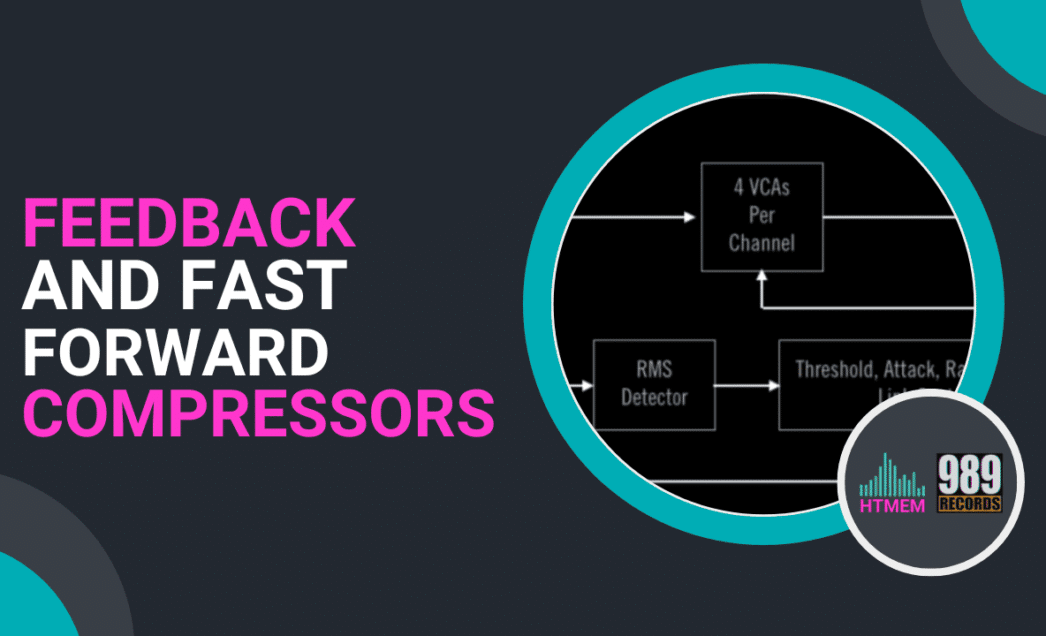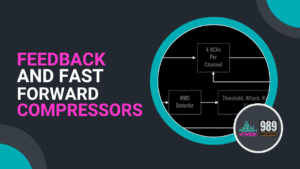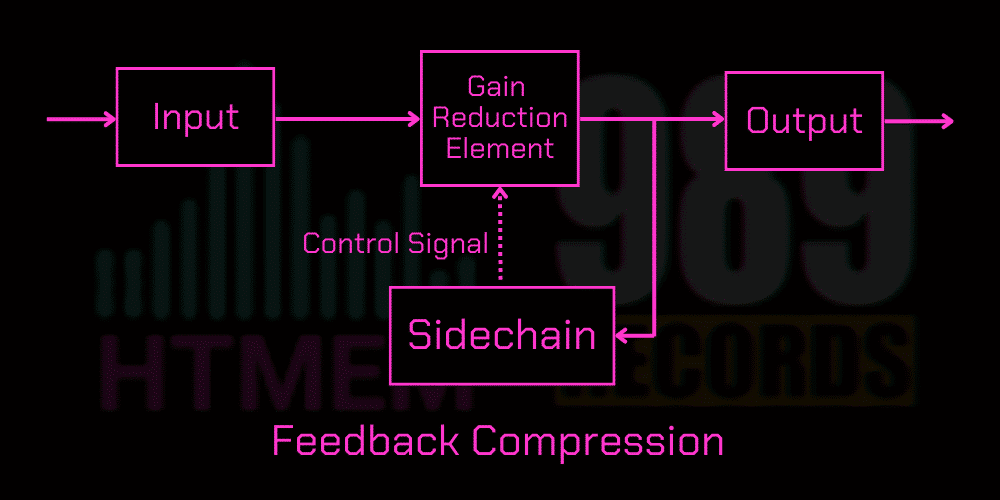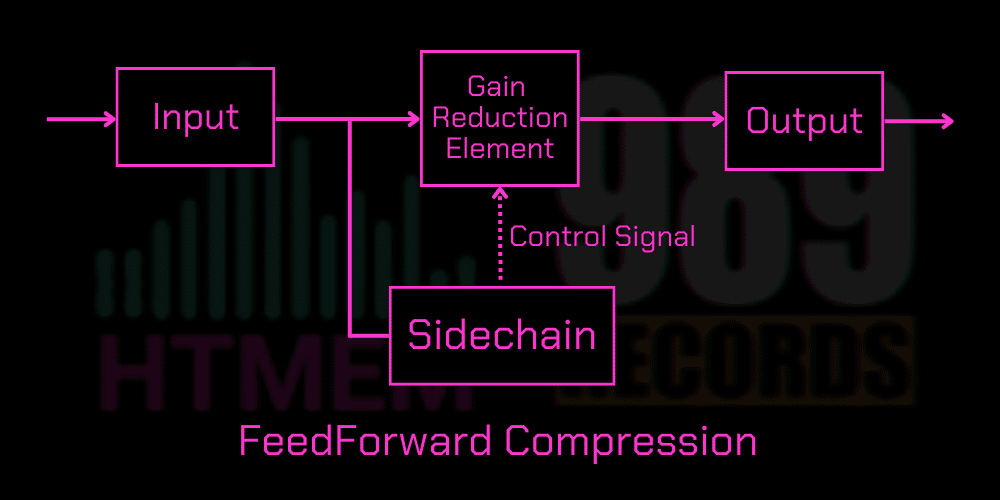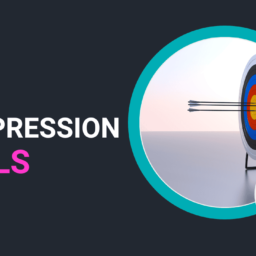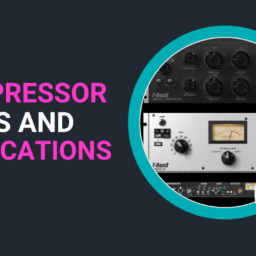When it comes to compressors, it’s essential to understand the core distinction between the two primary types: feedback and feedforward compressors, and how they manage the dynamic range of an audio signal.
The feedback compressor operates by taking a portion of the output signal and feeding it back into the input. This creates a loop where the compressor can continuously adjust its settings and compression levels based on the output signal.
The Feed forward compression, on the other hand, analyzes the input signal before applying gain reduction, allowing for more precise control over the compression process.
You probably already know that the sound usually gets compressed based on the input volume, the attack, the release, the threshold, and, where present, the ratio settings. But if you want to know more about compression controls, have a look here. Now, let’s dive into the topic of this post. Are you ready?
Understanding Compression
Compression is a fundamental audio processing technique used to control the dynamic range of an audio signal. By reducing the volume of loud signals and amplifying quieter ones, compression brings the overall level of the audio closer to a consistent average. This process is crucial in various audio applications, including music production, live sound, and post-production.
In music production, compression helps to even out the levels of vocals, instruments, and other audio sources, ensuring that no single element overpowers the mix. For instance, a vocal track might have varying volumes due to the singer’s dynamic performance. Applying compression smooths out these variations, making the vocal sit more consistently within the mix.
Live sound engineers also rely on compression to manage the dynamic range of live performances. By compressing the audio signal, they can prevent sudden volume spikes that could cause distortion or feedback, ensuring a clear and balanced sound for the audience.
In post-production, compression is used to enhance the clarity and impact of audio in films, TV shows, and other media. It helps to maintain a consistent audio level, making dialogue, sound effects, and music more intelligible and impactful.
Overall, compression is an indispensable tool in the audio engineer’s toolkit, providing control over the dynamic range of an audio signal and enhancing the overall listening experience.
What are Feedback and Feedforward Compressors?
Feedback and feedforward compressors are two fundamental types of compressors used in audio processing to manage the dynamic range of an audio signal. The primary distinction between them lies in their signal processing approach and the type of gain control element they employ.
Feedback compressors utilize a feedback loop to regulate gain reduction. In this configuration, the output signal is fed back into the input, creating a closed-loop system. This continuous monitoring of the output signal allows the compressor to adjust the gain reduction dynamically. Feedback compressors are renowned for their “musical” sound, often attributed to their less precise nature. This imprecision arises because the attack and release times are influenced by the ratio setting, offering less precise control compared to feed-forward compressors. They are a staple in analog compressors, providing a warm and rich tonal quality that many audio engineers and producers favor. However, feedback compressors, such as the SSL G-series bus compressor, can sometimes exhibit overshoots due to their detection process capturing the already altered signal.
On the other hand, feedforward compressors operate without a feedback loop. Instead, they rely on a separate control voltage to manage gain reduction. This method allows for more precise control over the compression process, making feedforward compressors ideal for applications requiring accuracy and consistency. Known for their punchy and direct sound, feedforward compressors are commonly found in modern VCA-based compressors, such as the SSL bus compressor. In contrast, many classic compressors adopted a feedback architecture.
By understanding these core differences, audio professionals can better select the appropriate compressor type for their specific needs, whether they seek the musicality of feedback compression or the precision of feedforward compression.
The Side Chain Circuit in Audio Signal Processing
Now, not to be confused with the side-chain input control, which we have already seen here, the so-called side-chain circuit is the detector circuit that generates the control signal, instructing the compressor to adjust the incoming signal level according to the settings we made.
So, depending on where the sound to be compressed is analyzed in the signal path, we can have two types of compressors: Feedforward and Feedback Compressors
Let’s understand something more.
Feedback Compressors
In a Feedback Compressor, the input signal is initially compressed with the setting we made, so attack, release, threshold, and ratio. Then, the same signal is rechecked at the output stage to see if the signal is above or below the threshold.
Feedback compressors continually monitor the compressed signal to make real-time adjustments, ensuring a smooth and musical sound. The attack and release times are influenced by the ratio setting, offering less precise control compared to feed-forward compressors.
Some classic Feed-Back Compressors are the Urei or Universal Audio 1176, the Optical LA-2A, the Neve 33609, EMI TG1, and many Tube compressors. Additionally, the Neve 2254 is another widely recognized feedback compressor. See Compressor types here.
Feed Forward Compressors in Modern Audio Systems
In a feed forward compressor configuration, the input signal is analyzed before the side-chain circuit, and the gain-reduction is consequently applied accordingly to the compressor settings. Feed forward compressors are known for their precise control and are commonly used in modern VCA-based compressors.
Classic Feedforward Compressors are the DBX 160 and a classic SSL Compressor, to name a few. For more compressor types, have a look here.
The compression circuit in feed forward compressors is designed to provide fast response times and accurate control over the signal, making them suitable for handling fast transients and hard-limiting applications. Of course, a Noise Gate has to be absolutely Feed-Forward.
Choosing the Right Compressor
Selecting the right compressor for your audio signal is crucial and depends largely on the sound you aim to achieve. Feedback compressors are often the go-to choice for those seeking a “musical” sound. Their smooth and gentle compression makes them ideal for applications where a warm, rich tone is desired. These compressors are frequently used in analog setups and are cherished for their ability to add character and depth to the audio signal.
In contrast, feedforward compressors are preferred for their punchy and direct sound. They excel in scenarios where aggressive compression is needed, such as in modern music production. The precise control offered by feedforward compressors makes them suitable for handling fast transients and hard-limiting applications, ensuring that the audio signal remains clear and defined.
When choosing a compressor, it’s also essential to consider the type of gain control element used. Feedback compressors typically employ a voltage-controlled amplifier (VCA) or a field-effect transistor (FET) as the gain control element. These components contribute to the characteristic sound of feedback compression. Feedforward compressors, on the other hand, often use a VCA or a diode bridge, which provides the precision and control necessary for accurate compression.
Ultimately, the decision between a feedback and feedforward compressor should be guided by the specific requirements of your audio signal and the desired sonic outcome. By understanding the unique attributes of each type, you can make an informed choice that enhances your audio production, whether you seek the musical warmth of feedback compression or the precise punch of feedforward compression.
Conclusions
Generally speaking, in terms of signal processing, feedforward compressors are more accurate than feedback compressors. Feedback comp designs are often favored for their musical sound, which is achieved by continuously monitoring the processed signal. Feedback compression generally produces a smoother, more musical sound, whereas feed-forward compression tends to be tighter and more punchy. But depending on the type of audio material, feedback compressors tend to sound more musical thanks to their less exact nature.
The gain reduction element in feedback compressors, such as a VCA or FET, contributes to their characteristic sound. Adjustments to the output gain can significantly influence the compression behavior and dynamics of the audio signal, making it an important factor to consider when choosing a compressor.
Currently, as of the date of this post, the only compressor able to blend a Feed-Forward and Feed-Back compressor type is the Great River PWM 501. Both feedback and feed-forward compressors can be designed to allow for a hybrid operation, combining elements of both types for enhanced versatility.
In comparison, the API 2500+ and the Neve Portico compressors can be switched between the two modes.
If you’re interested in learning more about the various compression controls and their functionalities, we have a comprehensive resource available for you to explore. Simply follow this link {here} to gain a deeper understanding of compression techniques.
Suggested Readings
Set Compression Goals
Feedback and Feedforward Compressors
Compressor Types and Applications
Audio Compression Controls
Why do we use Audio Compression?
Practice and Enjoy

